2022 Annual Report for: Erebidae / Arctiinae
For species seen in 2022 that had less than or equal to 100 records, full details are included; for more common species, the earliest, latest and highest count by vice-county are shown. The narrative for each species is taken from the main Hantsmoths website, and it is possible that some information on abundance and occurrence can get out of date, as it is impossible to keep up with all changes; however it should give a good introduction to each species. The tables in each species account summarise the previous status, and that for the current year.
For the maps, all records prior to 2022 are shown by a blue dot (the larger the dot, the more recent), with the current year's records shown in red. As previous records are superimposed on any report for 2022, new sites have greater emphasis (i.e. will show as 'more red').
In the species accounts, an asterisk next to a location indicates a new 10km square record; earliest ever dates are highlighted in orange, and latest ever in red. Initials in the species accounts refer to the recorders listed here. Please get in touch if you identify any omissions or errors, in particular if you have records that have yet to be submitted. Details of how to submit records can be found here.
72.019 [B&F: 2061] Buff Ermine Spilosoma lutea (Hufnagel, 1766) - Common
Common in a wide range of habitats, including gardens, hedgerows, parkland and woodland throughout England and southern Scotland, a species of conservation concern under the UK Biodiversity Action Plan. Widespread and common in Hampshire and on the Isle of Wight. Wingspan 34-42 mm. The females much darker than the males. Larva feeds on Stinging Nettle, Honeysuckle, Hop and Wild Plum, over-wintering as a pupa.
Records prior to 2022
| Vice County | #Records | #Individuals | First Record | Last Record |
|---|---|---|---|---|
| 10 | 1584 | 3960 | 1951 | 2021 |
| 11 | 13943 | 31490 | 1949 | 2021 |
| 12 | 4133 | 12088 | 1951 | 2021 |
2022 records
| Vice County | #Records | #Individuals | Max Quantity |
|---|---|---|---|
| 10 | 208 | 687 | 16 |
| 11 | 665 | 1314 | 22 |
| 12 | 261 | 607 | 15 |
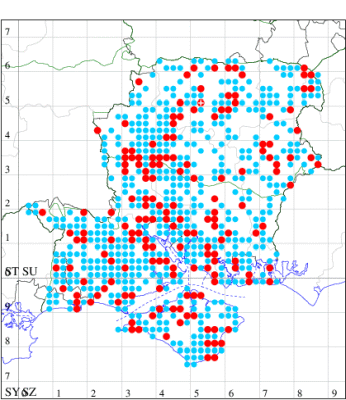
Records by year
Records by week (adult)
Records by week (larval)
Record Summary
VC10: Earliest: Brighstone, 01 May, 1 (AMas) Latest: Newport, 03 Sep, 1 (DPl) Max count: Shanklin, 22 Jun, 16 (IOu)
VC11: Earliest: Needs Ore NNR, 05 May, 1 (CNB) Latest: Botley, 09 Sep, 1 (SLB) Max count: Mark Ash Wood, NF, 11 Jun, 22 (STho, JT-M, MHar)
VC12: Earliest: Broughton, 10 May, 1 (GCE) Latest: Overton NR, Foxsdown, 02 Sep, 1 (TVH) Max count: Bulpits Hill, Vernham Dean, 10 Jul, 15 (JHal)
72.020 [B&F: 2060] White Ermine Spilosoma lubricipeda (Linnaeus, 1758) - Common
Common in gardens, hedgerows, grassland, heathland, moorland and woodland throughout the British Isles, a species of conservation concern under the UK Biodiversity Action Plan. Widespread and common in Hampshire and on the Isle of Wight. Wingspan 34-48 mm. Larva feeds on various herbaceous plants, especially Stinging Nettle and several species of dock, over-wintering as a pupa.
Records prior to 2022
| Vice County | #Records | #Individuals | First Record | Last Record |
|---|---|---|---|---|
| 10 | 893 | 2084 | 1981 | 2021 |
| 11 | 7794 | 16281 | 1947 | 2021 |
| 12 | 2554 | 7964 | 1951 | 2021 |
2022 records
| Vice County | #Records | #Individuals | Max Quantity |
|---|---|---|---|
| 10 | 97 | 190 | 17 |
| 11 | 328 | 625 | 12 |
| 12 | 181 | 462 | 22 |
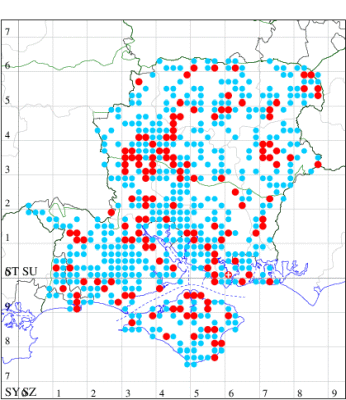
Records by year
Records by week (adult)
Records by week (larval)
Record Summary
VC10: Earliest: Totland, 21 Apr, 1 (RTer) Latest: Alverstone, 28 Aug, 1 (DFai) Max count: Porchfield, 17 May, 17 (MWhts)
VC11: Earliest: Botley, 21 Apr, 1 (SLB) Latest: Gosport, 04 Sep, 1 (RFri) Max count: Broughton, 02 Jun, 12 (GCE)
VC12: Earliest: Whitehill, 28 Apr, 1 (ASto) Latest: Overton, 17 Jul, 1 (ACr) Max count: Chawton, 09 Jun, 22 (DAS)
72.022 [B&F: 2063] Muslin Moth Diaphora mendica (Clerck, 1759) - Common
Common in open woodland, gardens and hedgerows, and on downland and sand-dunes throughout much of England, Wales and southern Scotland. In Hampshire and on the Isle of Wight widespread, but has declined recently. Wingspan male 30-35 mm, female 36-43 mm. The males are sometimes common at light, the females fly infrequently but are sometimes seen during the day. Male unmistakable, female is similar to White Ermine and Water Ermine, but smaller. Larva feeds on various herbaceous plants, including Dock and Dead-nettle, over-wintering as a pupa.
Records prior to 2022
| Vice County | #Records | #Individuals | First Record | Last Record |
|---|---|---|---|---|
| 10 | 438 | 794 | 1943 | 2021 |
| 11 | 3563 | 5361 | 1948 | 2021 |
| 12 | 1139 | 1860 | 1951 | 2021 |
2022 records
| Vice County | #Records | #Individuals | Max Quantity |
|---|---|---|---|
| 10 | 69 | 120 | 5 |
| 11 | 142 | 162 | 3 |
| 12 | 112 | 173 | 5 |
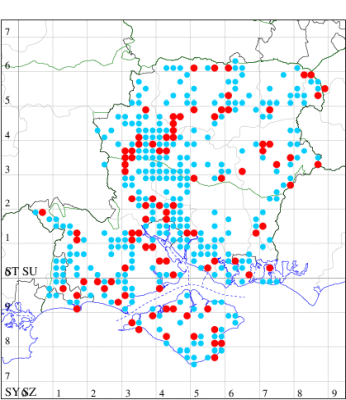
Records by year
Records by week (adult)
Records by week (larval)
Record Summary
VC10: Earliest: Bonchurch, 23 Mar, 1 (JHa) Latest: Newport, 29 Sep, 1 (DPl) Max count: Bonchurch, 28 Apr, 5 (JHa)
VC11: Earliest: Pennington, 11 Apr, 1 (RFC) Latest: Lee, 28 May, 1 (CTha) Max count: Horndean, 13 May, 3 (PHog)
VC12: Earliest: Alton, 10 Apr, 1 (DBO) Latest: Hammer Vale, Woolmer, 16 Jun, 2 (ASwa) Max count: Longstock, 10 May, 5 (GCE)
72.023 [B&F: 2059] Clouded Buff Diacrisia sannio (Linnaeus, 1758) - Local
Local on heathland, moorland and calcareous grassland throughout the British Isles. In Hampshire and on the Isle of Wight once locally frequent on the dry chalk, nowadays it is found only on the damp heaths of the New Forest and the north-east, with occasional wanderers appearing elsewhere. Wingspan male 40-50 mm, female 35-45 mm. Unmistakable. Larva polyphagous on various heathland plants, including Heather, Bell Heather, Sheep's Sorrel, Devil's-bit Scabious, Common Dog-violet, Ribwort Plantain and Greater Plantain.
Records prior to 2022
| Vice County | #Records | #Individuals | First Record | Last Record |
|---|---|---|---|---|
| 10 | 25 | 7 | 1856 | 2010 |
| 11 | 345 | 338 | 1800 | 2021 |
| 12 | 127 | 148 | 1951 | 2021 |
2022 records
| Vice County | #Records | #Individuals | Max Quantity |
|---|---|---|---|
| 11 | 6 | 10 | 5 |
| 12 | 2 | 2 | 1 |
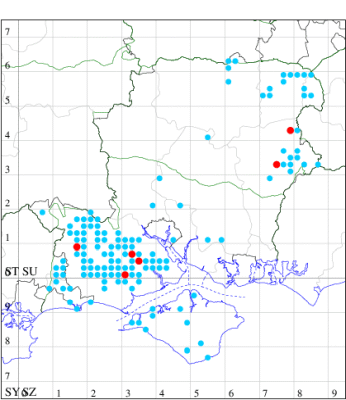
Records by year
Records by week (adult)
Records by week (larval)
Record Details
VC11: Ibsley Common, NF, one, field observation, 03 Jul; Rockford Common, NF, one, field observation, 03 Jul (BWT); The Commons, Roydon, NF, one, field observation, 14 Jun; one, field observation, 11 Jul (PWic); Matley Bog, NF, five, field observation, 13 Jun; Pig Bush, NF, one, field observation, 13 Jun (NRJ);
VC12: Selborne, one, 11 Jun (CJP); Bentley Station Meadow*, one, field observation, 11 Jun (CWhe)
72.024 [B&F: 2064] Ruby Tiger Phragmatobia fuliginosa (Linnaeus, 1758) - Common
Common on downland, heathland and sand-dunes, and in woodland clearings, farmland and gardens throughout England. Widespread and common in Hampshire and on the Isle of Wight. Wingspan 28-38 mm. Larva feeds on various herbaceous plants, including Common Ragwort, Ribwort Plantain and Greater Plantain.
Records prior to 2022
| Vice County | #Records | #Individuals | First Record | Last Record |
|---|---|---|---|---|
| 10 | 535 | 1062 | 1951 | 2021 |
| 11 | 6039 | 13106 | 1951 | 2021 |
| 12 | 2626 | 8004 | 1949 | 2021 |
2022 records
| Vice County | #Records | #Individuals | Max Quantity |
|---|---|---|---|
| 10 | 73 | 165 | 7 |
| 11 | 288 | 708 | 25 |
| 12 | 139 | 350 | 26 |
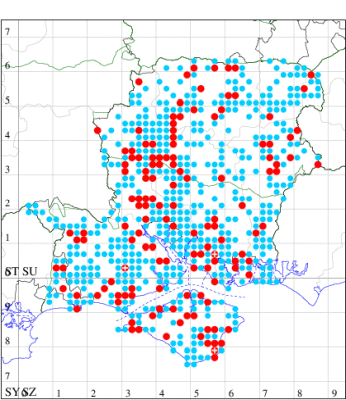
Records by year
Records by week (adult)
Records by week (larval)
Record Summary
VC10: Earliest: Coombe Bottom, Ventnor, 18 Apr, 1 (JMea) Latest: Alverstone, 03 Sep, 1 (DFai) Max count: Plaish, Carisbrooke, 20 Jul, 7 (KRyl)
VC11: Earliest: Fareham, 21 Feb, 1 (RJD) Latest: Fareham, 19 Sep, 1 (KJW) Max count: Botley, 20 Jul, 25 (SLB)
VC12: Earliest: Noar Hill HIWWT NNR, 21 Apr, 1 (BGD) Latest: Littleton, 12 Sep, 1 (GCE) Max count: Littleton, 23 Jul, 26 (GCE)
72.025 [B&F: 2056] Wood Tiger Parasemia plantaginis (Linnaeus, 1758) - Local
Local on heathland and downland throughout much of the British Isles, but has disappeared from many localities, especially in southern England. In Hampshire and on the Isle of Wight a species that has decreased dramatically through loss of habitat. It is still present on the remaining areas of unspoilt downland. Wingspan 33-42 mm. Sufficiently distinctive not be confused with other more common species of tiger-moth. Larva polyphagous on plants such as Bell Heather, Ribwort Plantain, Greater Plantain, Common Rock-rose, Salad Burnet and Groundsel.
Records prior to 2022
| Vice County | #Records | #Individuals | First Record | Last Record |
|---|---|---|---|---|
| 10 | 68 | 161 | 1800 | 2019 |
| 11 | 76 | 345 | 1940 | 2021 |
| 12 | 99 | 204 | 1949 | 2021 |
2022 records
| Vice County | #Records | #Individuals | Max Quantity |
|---|---|---|---|
| 10 | 5 | 6 | 2 |
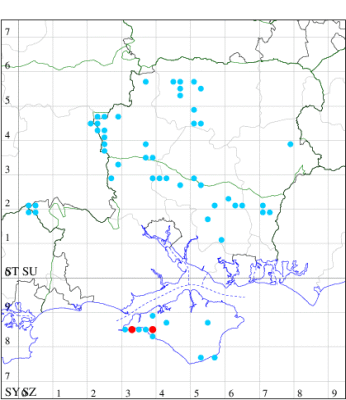
Records by year
Records by week (adult)
Records by week (larval)
Record Details
VC10: Tennyson Down, one, field observation, 09 Jun (SDav); two, 17 Jun (IOu); one, field observation, 08 Jun (SDav); Brook Down area, one, field observation, 01 Jun (DFai); Brook Down, one, field observation, 07 May (SSib det. JRB)
72.026 [B&F: 2057] Garden Tiger Arctia caja (Linnaeus, 1758) - Common
Reasonably common, but has declined drastically in recent years, in gardens, water meadows, marshes, fens, sand-dunes and open woodland throughout the British Isles, a species of conservation concern under the UK Biodiversity Action Plan. In Hampshire and on the Isle of Wight still widespread, but present only in small numbers. Wingspan 50-78 mm. Variable, but generally unmistakable. Larva feeds on various herbaceous plants, including Stinging Nettle, Broad-leaved Dock, Greater Burdock and Lesser Burdock.
Records prior to 2022
| Vice County | #Records | #Individuals | First Record | Last Record |
|---|---|---|---|---|
| 10 | 348 | 575 | 1951 | 2021 |
| 11 | 3930 | 9265 | 1951 | 2021 |
| 12 | 518 | 688 | 1948 | 2021 |
2022 records
| Vice County | #Records | #Individuals | Max Quantity |
|---|---|---|---|
| 10 | 42 | 60 | 6 |
| 11 | 85 | 105 | 6 |
| 12 | 9 | 9 | 1 |
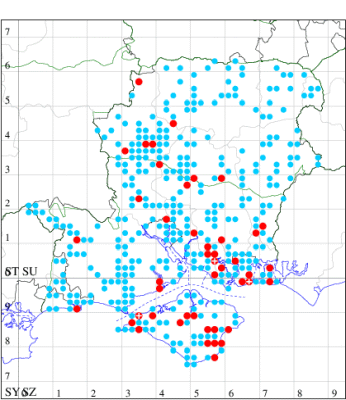
Records by year
Records by week (adult)
Records by week (larval)
Record Summary
VC10: Earliest: Norton Spit, 05 May, 1 (IOu) Latest: Alverstone, 14 Aug, 1 (DFai) Max count: Plaish, Carisbrooke, 21 Jul, 6 (KRyl)
VC11: Earliest: Southsea, 25 May, 0 (iNat) Latest: Portsmouth, 12 Sep, 0 (iNat) Max count: Fareham, 02 Aug, 6 (ADT)
VC12: Earliest: Nether Wallop, 03 Jul, 1 (GCE) Latest: Wherwell, 04 Aug, 1 (GCE) Max count: Nether Wallop, 03 Jul, 1 (GCE)
72.027 [B&F: 2058] Cream-spot Tiger Arctia villica (Linnaeus, 1758) - Local
Local on clifftops, undercliffs, saltmarshes and sand-dunes in southern England and South Wales, predominantly coastal. In Hampshire and on the Isle of Wight more or less confined to the coasts of vice-counties 10 and 11, where it is locally fairly common. Wingspan 50-66 mm. Could be confused with the occasional Scarlet Tiger Callimorpha dominula which has yellow hindwing. Larva feeds on White Dead-nettle, Black Horehound, Common Ragwort and Common Cow-wheat.
Records prior to 2022
| Vice County | #Records | #Individuals | First Record | Last Record |
|---|---|---|---|---|
| 10 | 407 | 848 | 1800 | 2021 |
| 11 | 547 | 928 | 1948 | 2021 |
| 12 | 3 | 0 | 1951 | 1951 |
2022 records
| Vice County | #Records | #Individuals | Max Quantity |
|---|---|---|---|
| 10 | 29 | 49 | 5 |
| 11 | 13 | 22 | 4 |
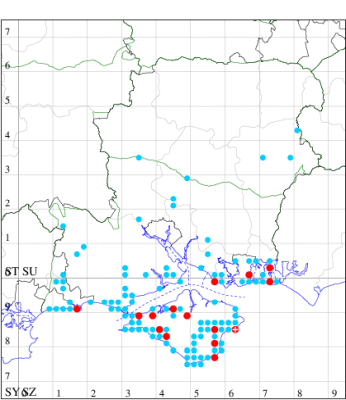
Records by year
Records by week (adult)
Records by week (larval)
Record Details
VC10: Yarmouth, present, 02 Jun (iNat); Cranmore, three, 19 May (JMar, JRB et al); Mottistone Down, one, field observation, 21 May (IOu); Brighstone, one, 29 May; one, 14 May (AMas); Newport, one, 22 May (DPl); Porchfield, two, 17 May (MWhts); Wheelers Bay, five, 17 May; three, 22 May; one, 17 Jun (ABut); one, field observation, 18 May (AJB, LB); Bonchurch, one, 19 Apr; one, 02 May; one, 07 May; one, 08 May; three, 09 May; two, 14 May; four, 15 May; three, 21 May; two, 22 May; one, 30 May; two, 01 Jun; one, 03 Jun; two, 04 Jun (JHa); Shanklin, one, 01 Jun; two, 06 Jun (IOu); Alverstone, one, 20 May; one, 28 May (DFai); Culver Down, larva, one, field observation, 18 Oct (IOu);
VC11: Portsmouth, two, 16 May; three, 18 May; one, 22 May; one, 30 May; two, 02 Jun (IRT); Northney, Hayling Island, present, 21 May (JWP); Hengistbury Head, one, 24 May; one, 06 Jun; three, 07 Jun; two, 08 Jun; four, 14 Jun (MJef); Browndown Coastal Ranges, one, reported, 22 May (RJC); Hayling Island, one, 18 May (STho)
72.029 [B&F: 2068] Scarlet Tiger Callimorpha dominula (Linnaeus, 1758) - Local
Local on river-banks, and in fens, marshes and damp meadows throughout south-western England and south Wales. In Hampshire still common in the Avon, Test, Itchen and Wey valleys and occasionally wanders elsewhere. Not recorded from the Isle of Wight to date. Wingspan 52-58 mm. Day-flying, but fairly frequent at over-night light traps. Usually, the bright red underwing precludes confusion with other tiger moths, however it occasionally has a yellow underwing, when it superficially resembles Cream-spot Tiger Arctia villica, but Cream-spot Tiger has a large white basal patch and is a more slender moth. Larva feeds on Common Comfrey, Hemp-agrimony, Stinging Nettle, Bramble, Honeysuckle and Meadowsweet.
Records prior to 2022
| Vice County | #Records | #Individuals | First Record | Last Record |
|---|---|---|---|---|
| 11 | 575 | 963 | 1800 | 2021 |
| 12 | 917 | 2154 | 1940 | 2021 |
2022 records
| Vice County | #Records | #Individuals | Max Quantity |
|---|---|---|---|
| 11 | 45 | 50 | 4 |
| 12 | 58 | 117 | 50 |
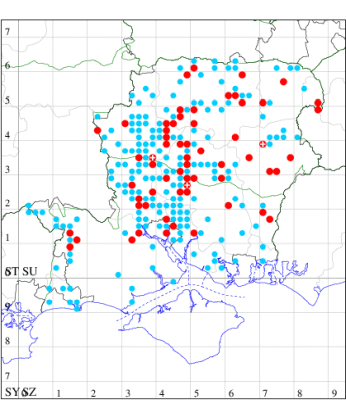
Records by year
Records by week (adult)
Records by week (larval)
Record Summary
VC11: Earliest: St Catherine's Hill disused sewage works, 20 Apr, 1 (DGG, SAC) Latest: Romsey, 18 Jul, 1 (SRC) Max count: Stockbridge Common , 19 Jun, 4 (GCE)
VC12: Earliest: Stockbridge Down, 07 May, 1 (AJB, LB) Latest: Cholderton, 20 Jul, 0 (HE) Max count: Winnall Moors HIWWT NR, 09 Jul, 50 (JWal)
72.030 [B&F: 2067] Jersey Tiger Euplagia quadripunctaria (Poda, 1761) - Nb
Locally common on sea cliffs, undercliffs, gardens, rough ground and hedgerows, mainly in south-western England. Predominantly coastal, it is probably most common in Devon but the 21st century has seen an increase in range along the coast to Dorset and the Isle of Wight, and increasingly on mainland Hampshire, and it continues to extend its range eastwards. There are also populations in London and Somerset, both of which may be as the result of accidental (or in the case of Somerset, deliberate) introduction.
First recorded on the Isle of Wight as a migrant in 1935, there were no further sightings in our area until one in Fareham, Hampshire on 12 August 1987. Low level residence was first suspected in the early 1990s, since when it has increased year on year on the island and is now locally frequent there (light traps in Ventnor have turned up 50-100 individuals on one night). With this, it was to be expected that frequency of sightings would increase on the mainland across the Solent, and it appears now to be resident (supplemented by dispersal from Wight) across the south Hampshire coast. It is making inroads inland and is increasingly reported across the county: it is very common in Surrey and East Berkshire, where populations have been expanding west from the London area, which may have originated from captive breeding releases, and the influx into north-east Hampshire more than likely originates from that source.
Wingspan 52-65 mm. Unmistakable. Larva feeds on herbaceous plants such as Stinging Nettle, Hemp-agrimony, White Dead-nettle, Ribwort Plantain, Greater Plantain, Ground-ivy and Bramble.
Records prior to 2022
| Vice County | #Records | #Individuals | First Record | Last Record |
|---|---|---|---|---|
| 10 | 897 | 3684 | 1877 | 2021 |
| 11 | 1013 | 1812 | 820 | 2021 |
| 12 | 21 | 21 | 2011 | 2021 |
2022 records
| Vice County | #Records | #Individuals | Max Quantity |
|---|---|---|---|
| 10 | 166 | 1087 | 61 |
| 11 | 641 | 1780 | 88 |
| 12 | 33 | 37 | 3 |
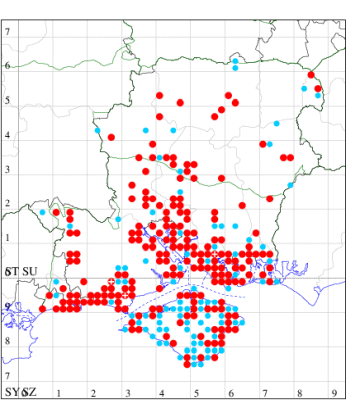
Records by year
Records by week (adult)
Records by week (larval)
Record Summary
VC10: Earliest: Wheelers Bay, 02 Jul, 1 (ABut) Latest: Bonchurch, 05 Sep, 1 (JHa) Max count: Bonchurch, 15 Aug, 61 (JHa)
VC11: Earliest: Fareham, 17 Apr, 1 (KJW) Latest: Wickham, 29 Aug, 1 (KdS) Max count: Browndown Coastal Ranges, 12 Aug, 88 (KCok, RJD, MLO, ADT, DWal)
VC12: Earliest: Winchester, 03 Jul, 3 (Unkn.) Latest: Cole Henley, 23 Aug, 1 (GCE) Max count: Chilbolton, 07 Aug, 3 (GCE)
72.031 [B&F: 2069] Cinnabar Tyria jacobaeae (Linnaeus, 1758) - Common
Common on grassland, sand-dunes, heathland, gardens and woodland rides throughout much of England and Wales, rare in Scotland, a species of conservation concern under the UK Biodiversity Action Plan. In Hampshire and on the Isle of Wight widespread and usually common, especially in the larval stage, on dunes, downs, open woodland and other places where the foodplant grows. Wingspan 35-45 mm. Unmistakable. Larva feeds on Common Ragwort, occasionally also on Oxford Ragwort, over-wintering as a pupa.
Records prior to 2022
| Vice County | #Records | #Individuals | First Record | Last Record |
|---|---|---|---|---|
| 10 | 656 | 2002 | 1951 | 2021 |
| 11 | 5103 | 11641 | 1945 | 2021 |
| 12 | 2641 | 10151 | 1951 | 2021 |
2022 records
| Vice County | #Records | #Individuals | Max Quantity |
|---|---|---|---|
| 10 | 42 | 81 | 40 |
| 11 | 136 | 238 | 35 |
| 12 | 79 | 146 | 20 |
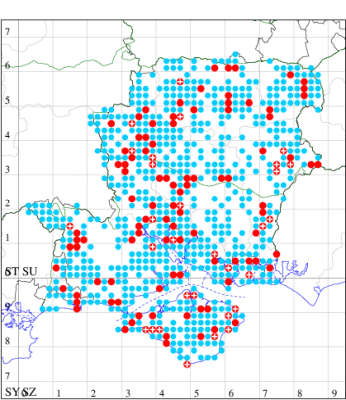
Records by year
Records by week (adult)
Records by week (larval)
Record Summary
VC10: Earliest: Wootton, 20 Apr, 1 (KShw) Latest: Northwood, 02 Aug, 0 (SArn) Max count: New Bridge Pools, St Helens, 17 Jul, 40 (IOu)
VC11: Earliest: Furzehill, NF, 03 May, 1 (SLoa) Latest: Queen Elizabeth CP, 27 Jul, 35 (SJDa) Max count: Queen Elizabeth CP, 27 Jul, 35 (SJDa)
VC12: Earliest: Overton, 19 May, 1 (ACr) Latest: Shortheath Common, 03 Aug, 0 (iNat) Max count: Abbotts Ann, 28 Jul, 20 (MGri)
72.034 [B&F: 2054] Crimson Speckled Utetheisa pulchella (Linnaeus, 1758) - Migrant
Rare immigrant from southern Europe, appearing in southern England. In Hampshire and on the Isle of Wight has appeared irregularly, with 2022 seeing an unprecedented influx. Wingspan 28-40 mm. Unmistakable in a natural context with other European species, although adventives from the Americas and Australasia of the same genus have occurred . Larva feeds on various herbaceous plants, no evidence of breeding in the UK.
Records prior to 2022
| Vice County | #Records | #Individuals | First Record | Last Record |
|---|---|---|---|---|
| 10 | 7 | 7 | 1870 | 2017 |
| 11 | 11 | 17 | 1800 | 2013 |
| 12 | 1 | 1 | 1961 | 1961 |
2022 records
| Vice County | #Records | #Individuals | Max Quantity |
|---|---|---|---|
| 10 | 4 | 3 | 1 |
| 11 | 14 | 15 | 2 |
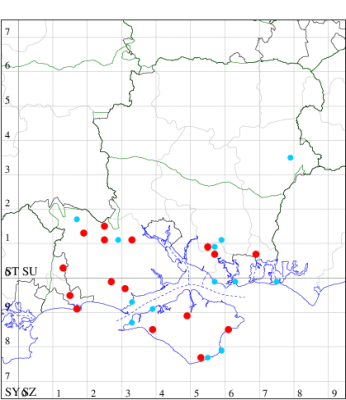
Records by year
Records by week (adult)
Records by week (larval)
Record Details
VC10: Dunsbury, one, field observation, flushed from grassland beside the path that heads north from Dunsbury reservoir, 03 Nov (IRid); Newport*, one, 25 Oct (DPl); St Lawrence, present, field observation, 26 Oct (DTre); Sandown*, one, field observation, 29 Oct (KCla det. JRB);
VC11: Avon Heath Country Park*, one, 16 Aug (Rbis); Latchmere Bottom, NF, one, field observation, 23 Oct; Latchmore Bottom, NF, one, field observation, 23 Oct (MJur); Highland Water Inclosure, one, field observation, 24 Oct (JBl); Bramble Hill, NF, one, field observation, 22 Oct (CPer); Woodlands, NF*, one, 10 Nov (RBW); Funtley, one, 26 Oct; one, 27 Oct (TDC); Fareham, one, 24 Oct (MLO); Bedhampton, Havant*, one, indoors, 27 Oct (Unkn.); Winkton Common, one, field observation, 28 Oct (GKin det. RPH); Stanpit Marsh LNR, two, 29 Oct (MGibb); Sway, one, field observation, 31 Oct (APep); Lymington, one, 11 Nov (ASH)
72.035 [B&F: 2037] Rosy Footman Miltochrista miniata (Forster, 1771) - Local
Local in broad-leaved woodland, heathland and mature hedgerows throughout southern England, but rare elsewhere; widely distributed and relatively common throughout Hampshire and on the Isle of Wight. Wingspan 25-33 mm. A beautiful and unmistakable moth. Larva feeds on various lichens.
Records prior to 2022
| Vice County | #Records | #Individuals | First Record | Last Record |
|---|---|---|---|---|
| 10 | 1178 | 5630 | 1951 | 2021 |
| 11 | 7560 | 20321 | 1949 | 2021 |
| 12 | 1929 | 6516 | 1951 | 2021 |
2022 records
| Vice County | #Records | #Individuals | Max Quantity |
|---|---|---|---|
| 10 | 165 | 726 | 31 |
| 11 | 441 | 1328 | 34 |
| 12 | 160 | 430 | 35 |
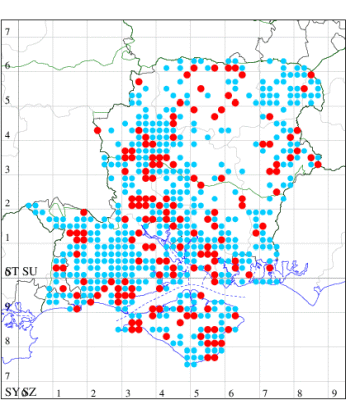
Records by year
Records by week (adult)
Records by week (larval)
Record Summary
VC10: Earliest: Briddlesford, 16 Jun, 2 (JRB) Latest: Ventnor, 28 Oct, 1 (MGT) Max count: Shanklin, 28 Jul, 31 (IOu)
VC11: Earliest: Chandlers Ford, 12 Jun, 2 (AMur) Latest: Marchwood, 30 Oct, 1 (CTha) Max count: Wickham, 18 Jul, 34 (JRDS)
VC12: Earliest: Pamber Forest, 17 Jun, 3 (GJD) Latest: Cole Henley, 26 Oct, 1 (GCE) Max count: Tidgrove Warren, nr Overton, 23 Jul, 35 (MJW, ACB)
72.036 [B&F: 2038] Muslin Footman Nudaria mundana (Linnaeus, 1761) - Local
Local in dry-stone walls and rocky areas throughout much of the British Isles. In Hampshire and on the Isle of Wight very local and uncommon in the area. There are very scattered records from all three vice-counties. Wingspan 19-23 mm. The most likely confusion species is Round-winged Muslin Thumatha senex, which see for differences. Larva feeds on various lichens, often on walls.
Records prior to 2022
| Vice County | #Records | #Individuals | First Record | Last Record |
|---|---|---|---|---|
| 10 | 131 | 244 | 1856 | 2021 |
| 11 | 24 | 19 | 1951 | 2021 |
| 12 | 31 | 36 | 1951 | 2020 |
2022 records
| Vice County | #Records | #Individuals | Max Quantity |
|---|---|---|---|
| 10 | 12 | 21 | 8 |
| 11 | 3 | 3 | 1 |
| 12 | 5 | 9 | 3 |
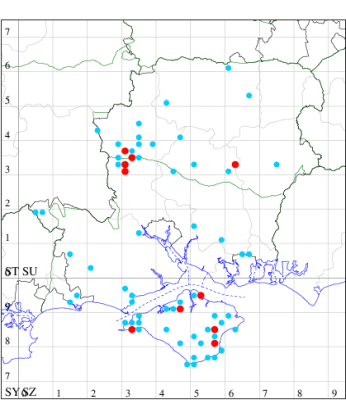
Records by year
Records by week (adult)
Records by week (larval)
Record Details
VC10: West High Down quarries, eight, 12 Jul; Parkhurst Forest, one, 02 Jul; Shanklin, two, 20 Jun; two, 03 Jul; one, 05 Jul; one, 06 Jul; one, 09 Jul; one, 10 Jul; one, 12 Jul (IOu); Alverstone, one, 02 Jul; one, 03 Jul (DFai); Osborne Wood, one, 23 Jun (IOu);
VC11: Broughton, one, 07 Jul; one, 07 Jul; one, 07 Jul (GCE);
VC12: Nether Wallop, one, 03 Jul; three, 03 Jul; two, 03 Jul; Broughton, one, 16 Jul (GCE); Ropley, two, 11 Jul (KrWil)
72.037 [B&F: 2035] Round-winged Muslin Thumatha senex (Hübner, [1808]) - Local
Local in fens, bogs, moorland, damp grassland and marshes throughout much of England. In Hampshire and on the Isle of Wight there are scattered colonies in bogs and marshes in all three vice-counties, with occasionally wanderers elsewhere. Wingspan 20-22 mm. The most likely confusion species is Muslin Footman Nudaria mundana, which differs in having two rather poorly-defined zigzag fasciae running across the less-rounded forewing, and fewer spots than Round-winged Muslin. Larva feeds on various lichens and various mosses.
Records prior to 2022
| Vice County | #Records | #Individuals | First Record | Last Record |
|---|---|---|---|---|
| 10 | 70 | 114 | 1900 | 2021 |
| 11 | 525 | 666 | 1800 | 2021 |
| 12 | 359 | 1162 | 1940 | 2021 |
2022 records
| Vice County | #Records | #Individuals | Max Quantity |
|---|---|---|---|
| 10 | 4 | 4 | 1 |
| 11 | 16 | 24 | 7 |
| 12 | 5 | 15 | 9 |
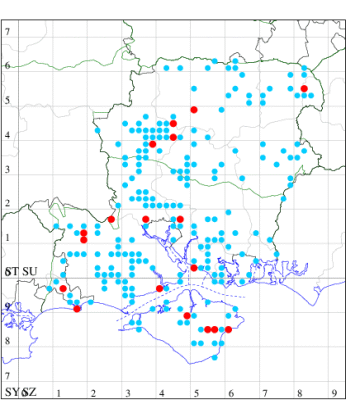
Records by year
Records by week (adult)
Records by week (larval)
Record Details
VC10: Newport, one, 17 Jun (DPl); Haseley Manor, one, 10 Jul (IOu); Alverstone, one, 03 Jul (GBro); Sandown, one, 29 Jul (IOu);
VC11: Ogden's Purlieu, NF, one, 12 Jul; Hasley, NF, present, 19 Jul (AMD); Wicksmoor Farm, Plaitford Common, NF, present, 13 Jul (RBW); Lee, two, 30 Jul (CTha); Needs Ore NNR, one, 16 Jul (CNB); Itchen Valley CP, one, 01 Jul (CTha); Brownwich cliffs, two, 17 Jun (RJD, MLO, ADT, DWal, KJW det. RJD); Hurn, one, 05 Jul; one, 30 Jul; one, 12 Aug; Hengistbury Head, one, 11 Jul (MJef); Needs Ore NNR, seven, 03 Jul; one, 05 Jul; nine, 10 Jul; one, 14 Jul; one, 21 Jul; one, 23 Jul; two, 25 Jul; one, 28 Jul; two, 17 Jul (CNB);
VC12: Chilbolton, two, 24 Jul; Longparish, nine, 23 Jun; Bullington, two, 16 Jun (GCE); Overton, one, 08 Jul (ACr); Fleet Pond, one, 06 Jul (MHals)
72.038 [B&F: 2040] Four-dotted Footman Cybosia mesomella (Linnaeus, 1758) - Local
Local on heathland, moorland, damp grassland, fens and open woodland throughout the British Isles. Widespread and fairly common in Hampshire and on the Isle of Wight. Wingspan 29-34 mm. Unmistakable. Larva feeds on lichens growing on various woody plants, including Heather and Sallow.
Records prior to 2022
| Vice County | #Records | #Individuals | First Record | Last Record |
|---|---|---|---|---|
| 10 | 94 | 91 | 1981 | 2020 |
| 11 | 1231 | 1531 | 1951 | 2021 |
| 12 | 776 | 1193 | 1951 | 2021 |
2022 records
| Vice County | #Records | #Individuals | Max Quantity |
|---|---|---|---|
| 10 | 2 | 3 | 2 |
| 11 | 33 | 52 | 10 |
| 12 | 35 | 63 | 13 |
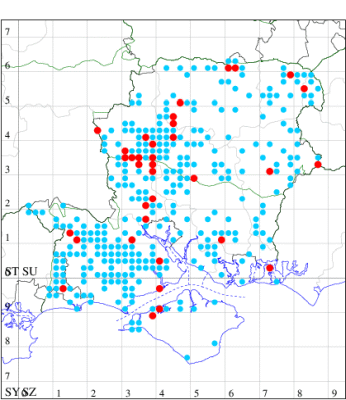
Records by year
Records by week (adult)
Records by week (larval)
Record Details
VC10: Cranmore, two, 21 Jun (JMar, JRB et al); Lower Hamstead, one, 26 Jul (KRyl);
VC11: Fordingbridge, one, 01 Jul (SCT); Furzehill, NF, one, 08 Jul (SLoa); Woodlands, NF, present, 21 Jul (RBW); one, 12 Jun; one, 22 Jun (CJon); Lee, one, 10 Jun (CTha); Romsey, one, 20 Jun (MJB); one, 25 Jun (NRJ); Houghton, one, 12 Jun; Stockbridge Common Marsh SSSI, one, 12 Jun; Stockbridge Down NT, two, 12 Jun; one, 12 Jun; two, 12 Jun; two, 12 Jun; Ashley, one, 11 Jul; Winter Down Copse, Little Somborne, one, 17 Jun; one, 17 Jun; Crawley, two, 22 Jun; one, 22 Jun (GCE); Dibden Purlieu, one, 02 Jul; one, 09 Jul (RAC); Wickham, one, 13 Jun (JRDS); Northney, Hayling Island, present, 16 Jun (JWP); Hurn, one, 17 Jun; two, 19 Jun; one, 20 Jun; one, 13 Jul (MJef); Needs Ore NNR, six, 18 Jun; 10, 03 Jul; three, 05 Jul; one, 10 Jul; one, 07 Jun; two, 25 Jun; one, 14 Jul (CNB); one, 16 Jun (NRJ, SIng); one, 21 Jul (CNB);
VC12: Cholderton, one, 01 Jul (TJN); Nether Wallop, one, 06 Jun; two, 03 Jul; two, 06 Jun; four, 03 Jul; Broughton, one, 21 Jun; two, 21 Jun; three, 21 Jun; Chilbolton, one, 19 Jun; Wherwell, one, 22 May; Longparish, two, 23 Jun; one, 23 Jun; Hurstbourne Priors, one, 23 Jun; one, 09 Jun; Bullington, one, 16 Jun; one, 16 Jun; Hurstbourne Priors, one, 25 May; one, 23 Jun; Cole Henley, two, 15 Jun; one, 15 Jun; one, 15 Jun; three, 15 Jun; two, 15 Jun; one, 05 Jul (GCE); Morn Hill, Winchester, one, 11 Jun (CRB, DAS, PDF et al); Pamber Forest, 13, 17 Jun; one, 11 Jul; two, 21 Jun (GJD); Noar Hill HIWWT NR, Selborne, one, 09 Jul (IBla); Castle Bottom NNR, one, 04 Jul; one, 04 Jul (BGD); Hammer Vale, Woolmer, two, 22 Jun; one, 29 Jun (ASwa); Fleet Pond, one, 06 Jul (MHals)
72.041 [B&F: 2051] Four-spotted Footman Lithosia quadra (Linnaeus, 1758) - Migrant
Local in broad-leaved woodland in southern England and western Wales, sporadically as far north as Ross-shire and the Isle of Man. It is probable that the population is from time to time reinforced by immigration. In Hampshire and on the Isle of Wight resident at low density in the New Forest and an uncommon, presumed, immigrant elsewhere. The individual pictured here was taken in the Isles of Scilly, where it is much more frequent. Wingspan male 35-40 mm, female 40-55 mm. Although only the female has spots, the large size precludes confusion with other Lithosiinae. The unspotted male is much more common to light then the female. Larva feeds on lichens growing on oak trees.
Records prior to 2022
| Vice County | #Records | #Individuals | First Record | Last Record |
|---|---|---|---|---|
| 10 | 972 | 5700 | 1856 | 2021 |
| 11 | 858 | 1435 | 1904 | 2021 |
| 12 | 233 | 508 | 1951 | 2021 |
2022 records
| Vice County | #Records | #Individuals | Max Quantity |
|---|---|---|---|
| 10 | 182 | 1453 | 171 |
| 11 | 127 | 275 | 13 |
| 12 | 26 | 40 | 9 |
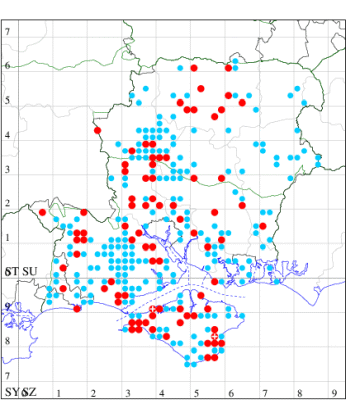
Records by year
Records by week (adult)
Records by week (larval)
Record Summary
VC10: Earliest: Cranmore, 07 Jun, 1 (NKow) Latest: Ventnor, 19 Oct, 1 (MGT) Max count: Shanklin, 18 Jul, 171 (IOu)
VC11: Earliest: Hurn, 28 Jun, 1 (MJef) Latest: Woodlands, NF, 04 Sep, 1 (CJon) Max count: Needs Ore NNR, 09 Jul, 22 (CNB)
VC12: Earliest: Overton, 16 Jun, 1 (ACr) Latest: Broughton, 18 Aug, 1 (GCE) Max count: Chilbolton, 18 Jul, 9 (GCE)
72.042 [B&F: 2039] Red-necked Footman Atolmis rubricollis (Linnaeus, 1758) - Local
Local in broad-leaved woodland and plantations throughout much of southern England and Wales. In Hampshire and on the Isle of Wight has increased from the mid 1980s onwards; after failing to appear in the county between 1971 and 1985, the species is now widespread across much of the county and on the Island. Wingspan 28-36 mm. Unmistakable. Larva feeds on lichens growing on Oak, Birch, Beech, European Larch, Norway Spruce and various trees, over-wintering as a pupa.
Records prior to 2022
| Vice County | #Records | #Individuals | First Record | Last Record |
|---|---|---|---|---|
| 10 | 57 | 64 | 1800 | 2021 |
| 11 | 292 | 395 | 1800 | 2021 |
| 12 | 86 | 114 | 1800 | 2021 |
2022 records
| Vice County | #Records | #Individuals | Max Quantity |
|---|---|---|---|
| 10 | 3 | 3 | 1 |
| 11 | 5 | 9 | 3 |
| 12 | 3 | 5 | 3 |
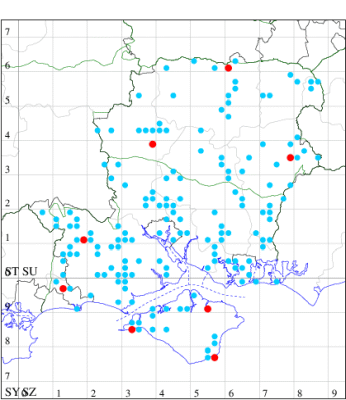
Records by year
Records by week (adult)
Records by week (larval)
Record Details
VC10: West High Down quarries, one, 12 Jul (IOu); Bonchurch, one, 22 Jun (JHa); Firestone Copse, one, 21 Jun (IOu);
VC11: Ogden's Purlieu, NF, three, 18 Jul (AMD); Needs Ore NNR, one, 09 Jul (CNB); Hurn, one, 16 Jun; two, 17 Jun; one, 22 Jun; two, 28 Jun (MJef);
VC12: Chilbolton*, one, 18 Jul (GCE); Pamber Forest, three, 17 Jun (GJD); Whitehill, one, 17 Jun (ASto)
72.043 [B&F: 2049] Buff Footman Eilema depressa (Esper, 1787) - Local
Local in broad-leaved woodland, mixed woodland, scrubby downland, scrubby heathland and fens throughout much of southern England and Wales. In Hampshire and on the Isle of Wight widespread and not uncommon, having increased in range over the last 20 years. Wingspan 28-36 mm. Distinctive once known, the relatively broad, plain wings give the species a characteristic appearance. The most likely confusion species is the pale straw-yellow form (ab. stramineola) of Dingy Footman E. griseola. Larva feeds on lichens growing on various deciduous and coniferous trees, including Oak, Birch, Hawthorn and Yew.
Records prior to 2022
| Vice County | #Records | #Individuals | First Record | Last Record |
|---|---|---|---|---|
| 10 | 570 | 1769 | 1930 | 2021 |
| 11 | 2415 | 5284 | 1951 | 2021 |
| 12 | 1166 | 3959 | 1951 | 2021 |
2022 records
| Vice County | #Records | #Individuals | Max Quantity |
|---|---|---|---|
| 10 | 69 | 291 | 40 |
| 11 | 152 | 353 | 13 |
| 12 | 66 | 130 | 10 |
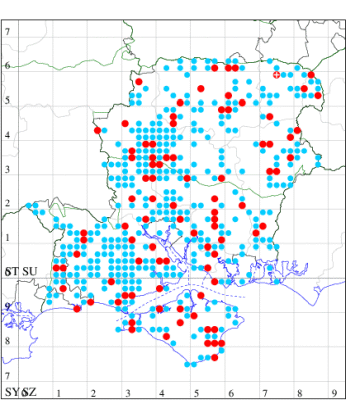
Records by year
Records by week (adult)
Records by week (larval)
Record Summary
VC10: Earliest: Shide, Newport, 21 May, 1 (CViny) Latest: Bonchurch, 24 Aug, 2 (JHa) Max count: West High Down quarries, 12 Jul, 40 (IOu)
VC11: Earliest: Botley, 14 Jun, 1 (SLB) Latest: Buttsash, Hythe, 26 Oct, 1 (JBl) Max count: Needs Ore NNR, 09 Jul, 34 (CNB)
VC12: Earliest: Hazeley Heath, Hartley Wintney, 15 May, 1 (FHut) Latest: Farnham, 21 Aug, 0 (iNat) Max count: Chilbolton, 31 Jul, 10 (GCE)
72.044 [B&F: 2044] Dingy Footman Eilema griseola (Hübner, [1803]) - Common
Common in fens, water meadows, damp grassland and rural gardens throughout southern England and Wales, north to Yorkshire. Widespread and common in Hampshire and on the Isle of Wight. Wingspan 32-40 mm. Either plain straw yellow (ab. stramineola) or grey with yellow costal streak, both forms best distinguished from Common Footman E. lurideola and Buff Footman E. depressa by characteristic wing-shape. Larva feeds on various lichens growing on deciduous trees and bushes.
Records prior to 2022
| Vice County | #Records | #Individuals | First Record | Last Record |
|---|---|---|---|---|
| 10 | 1095 | 4570 | 1951 | 2021 |
| 11 | 7305 | 19345 | 1949 | 2021 |
| 12 | 2588 | 12015 | 1951 | 2021 |
2022 records
| Vice County | #Records | #Individuals | Max Quantity |
|---|---|---|---|
| 10 | 144 | 1449 | 119 |
| 11 | 498 | 1743 | 44 |
| 12 | 222 | 940 | 140 |
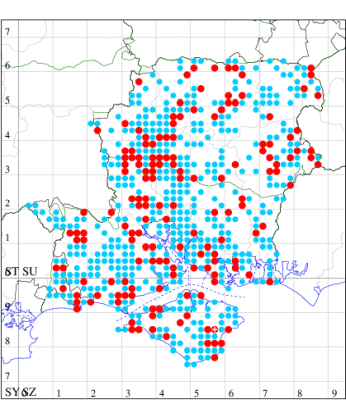
Records by year
Records by week (adult)
Records by week (larval)
Record Summary
VC10: Earliest: Alverstone, 04 Jun, 1 (DFai) Latest: Bonchurch, 15 Oct, 1 (JHa) Max count: Shanklin, 20 Jul, 119 (IOu)
VC11: Earliest: Sway, 15 Jun, 1 (SKee) Latest: Sway, 03 Sep, 1 (SKee) Max count: Needs Ore NNR, 16 Jul, 51 (CNB)
VC12: Earliest: Overton, 19 May, 1 (ACr) Latest: Chilbolton, 03 Sep, 1 (GCE) Max count: Tidgrove Warren, nr Overton, 23 Jul, 140 (MJW, ACB)
72.045 [B&F: 2050] Common Footman Eilema lurideola (Zincken, 1817) - Common
Common wherever there are lichens, in gardens, farmland, marshes and woodland throughout England, Wales and southern Scotland. Widespread and common in Hampshire and on the Isle of Wight. Wingspan 31-38 mm. Wing-shape and posture of live specimens is a far more reliable way of separating the various Eilema species than examination of prepared specimens, and familiarity with E. lurideola is the key to the identification of the other Eilema species; the most likely confusion species is Dingy Footman E. griseola, which see. Larva feeds mainly on various lichens, perhaps also on the foliage of various trees and bushes, including Hawthorn and Dogwood.
Records prior to 2022
| Vice County | #Records | #Individuals | First Record | Last Record |
|---|---|---|---|---|
| 10 | 1178 | 7098 | 1922 | 2021 |
| 11 | 10451 | 47018 | 1948 | 2021 |
| 12 | 3808 | 20413 | 1949 | 2021 |
2022 records
| Vice County | #Records | #Individuals | Max Quantity |
|---|---|---|---|
| 10 | 137 | 1848 | 158 |
| 11 | 532 | 2651 | 68 |
| 12 | 221 | 1416 | 120 |
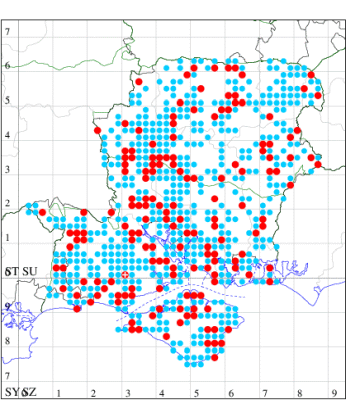
Records by year
Records by week (adult)
Records by week (larval)
Record Summary
VC10: Earliest: Bonchurch, 04 Jun, 1 (JHa) Latest: Freshwater Bay, 10 Aug, 2 (SDav) Max count: Shanklin, 18 Jul, 158 (IOu)
VC11: Earliest: Roydon Woods NNR, NF, 03 May, 1 (PDB) Latest: Furzehill, NF, 24 Aug, 1 (SLoa) Max count: Sway, 12 Jul, 68 (SKee)
VC12: Earliest: Chawton, 09 Jun, 1 (DAS) Latest: Magdalen Hill Down NR, 26 Aug, 1 (MF-R) Max count: Tidgrove Warren, nr Overton, 23 Jul, 120 (MJW, ACB)
72.046 [B&F: 2047] Scarce Footman Eilema complana (Linnaeus, 1758) - Local
Local in heathland, moorland, woodland, gardens and sand-dunes throughout England and Wales; widespread and common in Hampshire and the Isle of Wight. Wingspan 30-36 mm. Has been confused in the past with Common Footman E. lurideola, however wing-shape and posture of live specimens completely different; very similar to Hoary Footman E. caniola, which see. Virtually impossible to separate from Northern Footman E. sericea, now known only from Whixall Moss, Shropshire, and with which it is perhaps best treated as conspecific. Larva feeds on various lichens.
Records prior to 2022
| Vice County | #Records | #Individuals | First Record | Last Record |
|---|---|---|---|---|
| 10 | 471 | 1495 | 1981 | 2021 |
| 11 | 5509 | 12959 | 1951 | 2021 |
| 12 | 1740 | 4257 | 1949 | 2021 |
2022 records
| Vice County | #Records | #Individuals | Max Quantity |
|---|---|---|---|
| 10 | 63 | 255 | 29 |
| 11 | 283 | 618 | 44 |
| 12 | 130 | 276 | 20 |
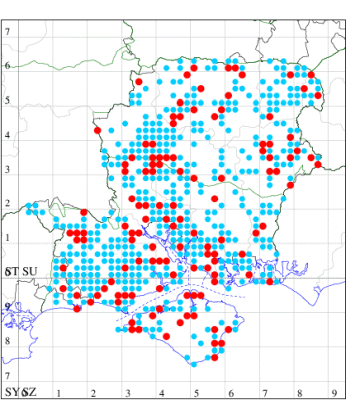
Records by year
Records by week (adult)
Records by week (larval)
Record Summary
VC10: Earliest: Freshwater Bay, 10 Jun, 5 (SDav) Latest: Freshwater Bay, 10 Aug, 1 (SDav) Max count: Bonchurch, 15 Jul, 29 (JHa)
VC11: Earliest: Allbrook, 15 Jun, 1 (SIng) Latest: Needs Ore NNR, 13 Aug, 5 (CNB) Max count: Needs Ore NNR, 23 Jul, 44 (CNB)
VC12: Earliest: Chilbolton, 19 Jun, 1 (GCE) Latest: Chawton, 01 Sep, 1 (DAS) Max count: Morn Hill, Winchester, 09 Jul, 20 (CRB, DAS, PDF et al)
72.047 [B&F: 2045] Hoary Footman Eilema caniola (Hübner, [1808]) - Nb
Nationally scarce (Nb) on sea cliffs and shingle beaches, and inland on quarries, from Kent to Anglesey. In Hampshire and on the Isle of Wight first recorded on the Island in 1992 and, on the mainland, in 1997, now increasingly seen in the north-east of the county where it is spreading from the east. Wingspan 28-35 mm. Very similar to Scarce Footman E. complana, but hindwing very pale yellowish grey (ochreous yellow in Scarce Footman), a feature which is difficult to see on live specimens. Larva feeds on various lichens, often on rocks.
Records prior to 2022
| Vice County | #Records | #Individuals | First Record | Last Record |
|---|---|---|---|---|
| 10 | 28 | 32 | 1981 | 2021 |
| 11 | 52 | 61 | 1993 | 2021 |
| 12 | 67 | 139 | 2003 | 2021 |
2022 records
| Vice County | #Records | #Individuals | Max Quantity |
|---|---|---|---|
| 10 | 5 | 5 | 1 |
| 11 | 14 | 13 | 2 |
| 12 | 9 | 11 | 3 |
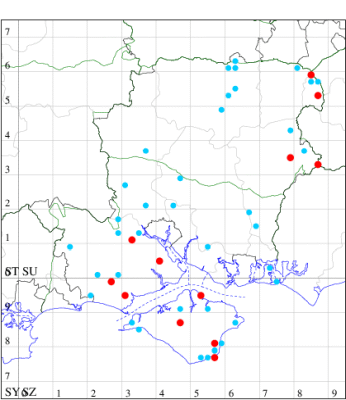
Records by year
Records by week (adult)
Records by week (larval)
Record Details
VC10: Plaish, Carisbrooke*, one, 20 Jul (KRyl); Bonchurch, one, 12 Aug; one, 14 Aug (JHa); Shanklin, one, 12 Jul; Osborne Wood, one, 13 Aug (IOu);
VC11: Woodlands, NF, present, 18 Jul (RBW); one, 13 Jul; one, 07 Aug (CJon); Dibden Purlieu, two, 16 Jul; one, 18 Jul; present, 19 Jul; one, 20 Jul; one, 24 Jul; one, 02 Aug (RAC); Sway, one, 10 Aug (SKee); Pennington, one, 01 Jul; one, 17 Jul; one, 27 Jul (RFC);
VC12: Whitehill*, one, 03 Aug (ASto); Hammer Vale, Woolmer, one, 05 Aug; one, 23 Aug (ASwa); Blackwater, one, 18 Jul; three, 19 Jul; one, 09 Aug (BGD); Farnborough, one, 13 Jul; one, 18 Aug; one, 22 Aug (KBW)
72.049 [B&F: 2043] Orange Footman Eilema sororcula (Hufnagel, 1766) - Local
Local in deciduous, especially oak and beech, woodland throughout much of southern England, chiefly in the south-west. In Hampshire and on the Isle of Wight still common in areas of oak woodland, and may even be extending its range. Wingspan 27-30 mm. Could be confused with ab. stramineola of Dingy Footman E. griseola, which is larger, has the costa more strongly arched, and the thorax and abdomen yellow (MBGBI Vol 9). Larva feeds on lichens growing on Oak, Beech and Blackthorn, over-wintering as a pupa.
Records prior to 2022
| Vice County | #Records | #Individuals | First Record | Last Record |
|---|---|---|---|---|
| 10 | 743 | 2502 | 1800 | 2021 |
| 11 | 3211 | 7429 | 1800 | 2021 |
| 12 | 1424 | 5663 | 1951 | 2021 |
2022 records
| Vice County | #Records | #Individuals | Max Quantity |
|---|---|---|---|
| 10 | 92 | 456 | 34 |
| 11 | 184 | 570 | 31 |
| 12 | 112 | 246 | 15 |
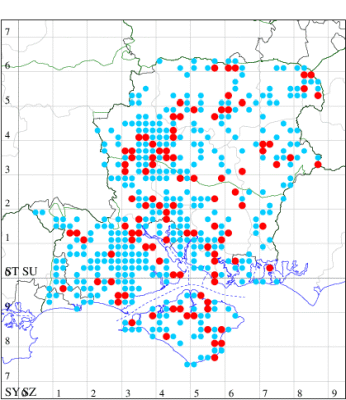
Records by year
Records by week (adult)
Records by week (larval)
Record Summary
VC10: Earliest: Bonchurch, 28 Apr, 1 (JHa) Latest: Shanklin, 08 Jul, 1 (IOu) Max count: Shanklin, 22 May, 34 (IOu)
VC11: Earliest: Romsey, 03 May, 2 (NRJ) Latest: Hurn, 23 Jul, 1 (MJef) Max count: Wickham, 21 May, 31 (JRDS)
VC12: Earliest: Hammer Vale, Woolmer, 24 Apr, 1 (ASwa) Latest: Hammer Vale, Woolmer, 10 Aug, 1 (ASwa) Max count: Hammer Vale, Woolmer, 20 May, 15 (ASwa)
72.050 [B&F: 2036] Dew Moth Setina irrorella (Linnaeus, 1758) - Nationally Rare
Nationally scarce (Na) on shingle beaches and rough grassland by the sea in southern England, western Wales and Scotland; also, rarely, on calcareous grassland inland in Surrey and the Cotswolds. In Hampshire and on the Isle of Wight the headquarters of this species in the area are on the cliff-tops at Freshwater on the Island, and there is also a good colony at Hurst Castle on the mainland. Elsewhere, occasional presumed strays have been taken at light. Wingspan 26-32 mm. Unmistakable. Larva feeds on various lichens.
Records prior to 2022
| Vice County | #Records | #Individuals | First Record | Last Record |
|---|---|---|---|---|
| 10 | 53 | 113 | 1900 | 2021 |
| 11 | 35 | 57 | 1900 | 2014 |
2022 records
| Vice County | #Records | #Individuals | Max Quantity |
|---|---|---|---|
| 10 | 5 | 11 | 6 |
| 11 | 2 | 12 | 7 |
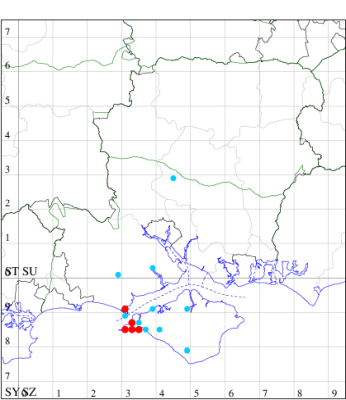
Records by year
Records by week (adult)
Records by week (larval)
Record Details
VC10: Tennyson Down, one, field observation, 24 May (D&NFea); West High Down quarries, one, 12 Jul (IOu); Totland, one, 28 May (RTer); Tennyson Down East, six, 17 Jun; Freshwater Bay, two, 17 Jun (IOu);
VC11: Hurst Castle, five, field observation, 18 Jun (CJon); seven, found by searching vegetated shingle for an hour, 17 Jun (NRJ)




